Year after year farmers in the US plants a lot of corn. A safe estimate is around 80 million acres with another 70 million acres or so going to soybeans. Corn comes from South America, soybeans are from East Asia. When we plant these crops we plant them in such a way that we exclude or, at the very least, limit the ability of native plants to grow. A safe estimate is that 99 percent of our cropland is planted in non-native species. I’d like to get your opinions on whether it’s OK for us to go to such efforts to control invasive species like kudzu and buckthorn when, on the flip side, we’re going to so much effort to encourage other species which don’t come from here.
Author: jeffgillman003
Our visiting Garden Professor and his Kentucky coffeetree
By Dr. Charlie Rohwer
Since my last guest professor submission (buying organic food for health) garnered so much discussion, I thought I’d try to write about a less controversial topic: evolution. There’s no scientific doubt that’s where plants (well, all species of everything, really) come from, but what got me thinking about it recently was my Kentucky coffeetree.
My wife and I bought our first house a couple years ago, and for the previous 25 years at least, the landscaping had been severely neglected. Ubiquitous rock mulch on top of plastic, a cherry covered in black knot, and zero space used for any kind of garden, unless you count the 2 sedum suffering under rocks and plastic. So we made lots of garden space and bought our first tree, a Gymnocladus dioicus. But as the epithet indicates, Kentucky coffeetree is dioecious. The plant either has male flowers or female flowers. We liked the fact this tree will get tall but not spread too wide, tolerate our soil, have interesting bark and leaves, and the winter shade will be fairly sparse, but we didn’t really want to have the big seed pods from the females. We bought an unsexed plant in 2009 and hoped for the best. Make no mistake, we were proud parents, regardless of the sex of our newly-planted 7-foot stick. It flowered this year, with only stamens. It’s a boy! But it got me thinking, where and when did its dioecism come from? It amazed me that I hadn’t considered it before because I actually work with another dioecious plant, hops (Humulus lupulus).

Flowering plants probably started their evolutionary timeline with both male and female parts near each other. Carpels (female) and stamens (male) are specialized places where male and female gametes (sperm and egg) are made, fused, and the young sporophyte, as a developing embryo, is protected in maternal structures. Sounds familiar, but as Bert stated in a recent post, we need to strictly avoid teleology. In fact, though more common in some parts of the world, dioecism is the exception in flowering plant reproduction (<10% of species). Most flowers you see are hermaphroditic, with both male and female parts together in the same flower. Dioecism is so dispersed among plant genera, it’s probably evolved many different times, and is thought to arise through a series of evolutionary steps. For example, in one mechanism, some individuals within a species loose the ability to make pollen (genetically), and some plants within that species can still produce both male and female flowers. Then selection can act on the two types of plants separately, and at some point, the ability to make female parts disappears in the hermaphroditic line. But there are different ways to arrive at dioecism that help to explain how it arose multiple times in so many diverse plant lineages. Genera other than Gymnocladus (a legume) and Humulus (complicated taxonomy, but clearly related to Cannabis) that have evolved to be dioecious include Spinacia (spinach, an amaranth), Pistacia (pistachio, in the cashew family), Asparagus (a monocot), Dioscorea (yam, in the….yam family), and Ginkgo (not even classified as a flowering plant, and not a conifer either!).

Kentucky coffeetree is a legume, but think of every other legume you know and dioecism is the exception, by far. Pollination and dispersal mechanisms, optimization of reproductive resources, and outcrossing pressure are thought to drive evolution of these species away from hermaphroditic flowers. Evidently this happened to the Kentucky coffeetree lineage by 50 million years ago. About 40 percent of the time that flowering plants have existed, Gymnocladus has been dioecious. That’s 1 million times longer than a 50-year-old person has existed. Dinosaurs had been extinct for 15 million years or so by the time the Kentucky coffeetree lineage split from other legumes. Those are numbers we have a hard time grasping because natural processes have been around a lot longer than we have.
Reading:
Ainsworth, 2000. Boys and girls come out to play: the molecular biology of dioecious plants. Ann. Bot. 86:211–221.
Doyle and Luckow, 2003. The rest of the iceberg. Legume diversity and evolution in a phylogenetic context. Plant Physiology 131:900–910.
Specht and Bartlett, 2009. Flower evolution: the origin and subsequent diversification of the angiosperm flower. Ann. Rev. Ecol. Evol. Syst. 40:217–243.
Dirty Dozen?
Nobody in their right mind considers pesticides safe. They are, after all, poisons which we have created to kill things, be those things plants, insects, fungi, rats, or whatever. The idea that we could have foods with no pesticides on them is attractive. Now I’ve got to admit that, as a general rule, I don’t think that the levels at which most pesticides are found on foods is concerning. Our methods of detecting poisons are just too sensitive today and so we end up saying that a poison is “present” on a tomato or whatever even if it’s there at a harmless parts-per-trillion level. Still, I won’t deny that I’d prefer it if there were no synthetic pesticides on any food.
A couple of days ago a report came out from CNN about the “dirty-dozen.” http://www.cnn.com/2010/HEALTH/06/01/dirty.dozen.produce.pesticide/index.html This is a list of the twelve fruits and vegetables which are most likely to have detectible levels of synthetic pesticide residues. Along with this list there is a suggestion that, when purchasing these fruits and veggies, you should select those that are organically produced whenever possible. I don’t have a problem with this list being reported. In fact, I think it’s a good idea to give people all of the information that we can about pesticides. While I, personally, am not particularly afraid of conventionally produced fruits and veggies because of the synthetic chemicals which they may contain I appreciate the fact that others might be. I do, however, have a major problem with the idea that organically produced fruits and veggies are necessarily safer than those produced with synthetics. You see, organically produced food is not tested for residues of potentially damaging organic pesticides, and those same foods that are slathered by synthetic pesticides in non-organic growing systems are typically slathered by organic pesticides in organic systems, particularly if you’re dealing with foods produced using what has become known as “industrial organic production” which fill most of our large grocery stores with USDA Certified Organic Produce nowadays. These organic pesticides may be present at higher concentrations than synthetic pesticides and may have similar effects on humans, and even worse effects on the environment than synthetics (though it depends on the exact pesticides used and how often they are used of course).
The myth that organic foods don’t have pesticides used on them is one that really needs to die. No farmer, organic or non-organic, wants to use pesticides, and sometimes they can get away without using them. Certain crops are rarely sprayed regardless of whether they’re produced organically or not. Pesticides cost money and are dangerous, but when faced with the potential loss of a crop producers will do what they need to do to avoid losing their crop, and if that means applying pesticides then so be it. Organic farmers may choose to use different pesticides, and they might wait longer before they spray (although often they spray sooner because the relative efficacy of their sprays are inferior to synthetic sprays) but let’s not say that organically produced foods are free of pesticide reside. Just because we’re not testing for it doesn’t mean it isn’t there.
Right and Left
Just got a picture of the cover of a new book I’ve got coming up soon. It’s a collaborative project with an old friend of mine who is a political science professor at UNC Charlotte. We look at a bunch of different environmental issues, different things that the government could do about these issues, and then we rate these options by how the well the right and left wingers would like them. Sure to tick people off! The book won’t be out till next January — It’s typically over a year between when something is first turned in and when it comes out — that’s just publishing.
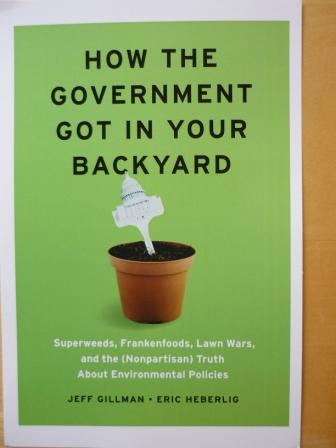
Do Organophosphates cause ADHD?
Ever since Monday’s post I’ve been preoccupied thinking about that article which was mentioned in the comments section by Daniel http://www.cnn.com/2010/HEALTH/05/17/pesticides.adhd/index.html?iref=allsearch . This article basically summarized a study that seemed to show that ADHD in children was related to exposure to organophosphate insecticides.
Articles like this appear all of the time in mainstream media and they scare the bejezus out of us because, after reading them, we end up thinking “Holy crap! We’re killing ourselves and ruining our society with these insane chemicals!” Most of the time, however, this just isn’t the case. Look, if everything that the papers reported about the negative effects of pesticides and other chemicals was true we’d all have cancer, mental illness, or we’d just be dead.
After the above you’re probably telling yourself that I’m some kind of maniacal chemical apologist. Maybe I am, but I don’t think so. I’ve spent a lot of time reading the actual articles from which these media pieces are written and I like to think I have a relatively balanced view of these chemicals – maybe I’m deluding myself though – I’ve been known to do that on occasion. In any regard, what I’m going to do with this blog post is to take a look at the media article and let you know some of the questions that I want answered before I get very concerned about the research, and by answered I mean answered by the scientific article from which the media piece was derived. Now, to be fair, I have not read the actual scientific article from which this media piece was derived. It isn’t online as I’m writing this (at least nowhere that I can find it), though I have no doubt that it will be soon. I suppose that I could have waited to write this until it came out, in fact I considered that idea carefully, but instead I thought that I would tell you about the things that I’m wondering about the article; In other words, the things that I’ll be looking for when I finally get to read it. Media people want POW! Scientists want to know what’s actually going on.
Before we begin I should tell you that I’m no fan of organophosphates. They include a wide range of chemicals (though they are, obviously, all related in that they’re organic chemicals with phosphorus), some worse than others – from the relatively tame orthene and malathion to the scary-as-hell disulfoton (aka disyston). Right now, as an extension specialist who works with growers, I can tell you that organophosphate chemicals are, in general, not a preferred choice for most growers simply because there are so many safer and more effective choices out there. My feelings about organophosphates can best be summed up by what I wrote in my book The Truth About Organic Gardening “[Organophosphates] are an old class of insecticides that has served its purpose and for the most part should probably go the way of the dodo, with the possible exception of orthene and one or two others.”
So here we go, the things that I will be looking for when I read the actual scientific article:
1. What’s the confidence interval? In the media article it was stated that children with higher levels of organophosphates were about two times more likely to have ADHD, but no confidence interval was given. In epidemiological studies such as this the likelihood of a given outcome is usually expressed as an odds ratio. In this case the odds ratio that a child would develop ADHD given a high level of organophosphate exposure would be about 2 (because it would be 2 times as likely that a child would develop ADHD as it would be if the child weren’t exposed to the organophosphates). But in a scientific article the odds ratio will always be coupled with a confidence interval. A confidence interval tells you how confident you are in your odds ratio. If you’re very confident then you’ll have a narrow confidence interval – maybe 1.8-2.2 — which means that it is 95% certain that the odds ratio is between 1.8 and 2.2 (the 2.0 odds ratio is basically just the most likely point on the confidence interval for the odds ratio to sit. It’s kind of like, but not exactly the same as, an average). For an epidemiological study that’s darn good. If that’s the confidence interval present in the article then I’ll be impressed. What we might find though is a confidence interval of something like 0.2 to 22. That stinks and you’re deluding yourself if you think that a confidence interval like this “proves” anything – unfortunately I have seen plenty of media articles use research with confidence intervals such as this because of the POW! factor. They ignore the confidence interval and just look at the odds ratio. My guess is that this article has something in between the two confidence intervals which I listed above – we’ll see.
2. I want to know how often urine was sampled.
Organophosphates move through the body very quickly. In fact, I was recently reading a paper which showed that you can’t predict from one test time to the next what organophosphate readings will be because there’s so little consistency. If you’re exposed to an organophosphate one day you may test high that day, but two days later you’ll be testing low again, so, I want to know if a single sample was done – which I would consider to be almost useless in terms of telling us actual organophosphate exposure – or if multiple samples were taken over time which I would consider to be much more useful.
3. Did the organophosphate really come from food? The implication that these organophosphates which, in theory, contributed to the onset of ADHD came from food bugs me. I want to see if the author actually draws this conclusion in the paper or if it was made up by the media. There are lots of places that organophosphates are and have been used, the singling out of fruits, vegetables, or any food seems ridiculous to me. The author of the media article points out that organophosphates are not used around homes much – but that really isn’t the case and it certainly wasn’t the case just a few short years ago. There are still plenty of organophosphates being used quite regularly around homes. I just did a search for orthene and malathion and found that I could buy them quite easily online. Diazinon and chlorpyrifos are two others that shouldn’t be used by homeowners but which I know of people using – sometimes in heavily trafficked areas.
4. I’d like to know about how the other potential contributors to ADHD were controlled. There are other things that have been correlated with ADHD, how were these controlled so we know they weren’t the cause of the ADHD measured in this experiment? For example, abused or neglected children seem to have a higher rate of ADHD, how was this taken into account in the study? Was it taken into account? A theory would be (and I’m totally making this up) what if abused children are fed more food with higher rates of organophosphates while non-abused children are fed more organic food. Then the results would show that the neglected kids had higher ADHD and higher organophosphates – but was it the poor parenting or the organophosphates which caused the ADHD?
So, those are the four questions that I’ll be asking right off – and there are more that I’ll think of once I actually read the article. All of these questions don’t mean that I think the article is bad though – regardless of what their answers are. This research was probably well conducted and will enlighten scientists and lead to new avenues of research. But, I’m willing to bet that the POW! from the media article (ADHD is caused by eating organophosphates on food) isn’t quite as powerful when the whole article is read with a more critical eye.
Visiting Professor guest post: Organic foods
There are lots of reasons consumers give for buying organic foods, but a few reasons are very common. Among them is the notion that organic foods are better for you. Really? Are organic fruits and veggies better for you? Depends on what you mean by ‘better for you’. But as far as we know, the answer is probably ‘no’, especially if you’re buying organic fruits and veggies (F&V) at the store. It might seem crazy, but there’s no good evidence to support the notion that you will be more healthy by shopping for organic F&V. There are some complicated reasons for this, and some areas we aren’t quite sure about yet, but I’ll try to explain.

If ‘better for you’ means ‘fewer pesticide residues,’ you’re right. But if you think ‘fewer pesticide residues’ means ‘better for you,’ that gets murky. Why do we apply pesticides? We do it to protect our food from pests and diseases. It’s cheaper and more productive than destroying blight-infected tomatoes, individually wrapping apples in a protective barrier, or throwing away heads of cabbage with worms. But why do those things matter? It turns out we’re just consumers. Two big things we look for when buying F&V are appearance and cost. If a person has a choice between a spotty, more expensive apple and a uniformly bright and shiny lower-cost apple, he’ll probably choose the latter. And which would be better, buying 2 heads of cauliflower because it’s pretty and low-cost (conventional), or buying one head because it has a slight cosmetic defect and costs a little more (organic)? You guessed it; in terms of your health, it’s more likely that 2 heads are better than 1. If that isn’t complicated enough, consider that there are no good long-term human studies concerning the health effects of pesticide residues ingested from food. There’s no evidence that eating conventional F&V, even with the elevated risk of consuming more pesticide residues, is worse for you than eating organic F&V. But there is evidence that eating more F&V is better for you than eating less. So why eat less?
Some of the best health care in Minnesota comes from the Mayo Clinic. What? Who cares about the Mayo Clinic? In Minnesota, we worship the Mayo Clinic. [undeserved pride] They represent some of the finest health care in the country [/undeserved pride]. And what does the Mayo Clinic have to say about pesticides on our food? “Most experts agree…that the amount of pesticides found on fruits and vegetables poses a very small health risk.”

But what about nutrients—don’t organic foods have more nutrients or something good in them? Maybe they do have fewer nitrates (which may be bad for you, especially if you’re too young to read this), but that really depends on how the specific growers use fertilizers. Maybe some organic produce tends to have more vitamin C, but that can vary too. And even if the organic tomato you’re eating has more vitamin C than the conventional tomato you passed up, is that physiologically relevant? Does it matter to your body? We don’t have any good evidence that it is.
Why am I being so down on organics? Mostly because I like to play devil’s advocate. I buy a lot of organic F&V. There are some reasons to buy organics that may be more legitimate than “it’s better for me”. Sadly, research seems to indicate that I buy organic F&V to make myself feel good for buying it, not because it’s actually better for me. But in general, eating healthy means eating more fruits and vegetables.
Charlie Rohwer is a horticultural scientist at the University of Minnesota Southern Research and Outreach Center. He has an MS from Michigan State University and a PhD from the U of M. He currently studies vegetables and things that make them good for you.
Building a Better Container
As most of you know, roots circling around a container isn’t considered a good thing. And so people try various things to control circling roots. One of the more creative horticultural minds out there, Carl Whitcomb, a guy why basically got sick of academia and went into private industry (and, as far as I can tell, loathes peer review and the whole process of publication), decided to see what he could do about making containers that don’t encourage circling roots. He came up with a number of designs, but my favorite is the RootTrapper. The container is made of a flexible cloth which roots get lodged in, preventing them from circling. Not that I’ve never seen a circling root in a RootTrapper, it’s just that these circling roots are extremely rare.

A row of elms in RootTrappers
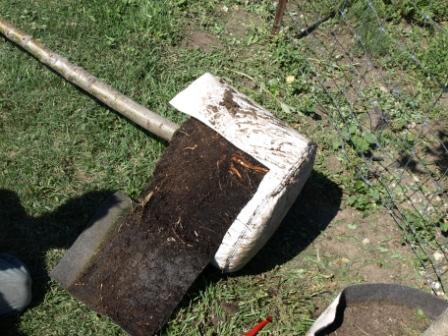
A cut open RootTrapper
This is one of those innovative products that really works and it surprises me that so few people use this growing system. Yes, it’s a bit more expensive than standard containers, and yes, it does take a little more effort to take the tree out of this container than a smooth sided one. But man, I’ve never seen a better root system come out of a container than those which you get out of these.
The Approach Graft
Seeing as this blog is called “The Garden Professors” it has been far too long since we’ve given you a lecture on a useful practice for your garden, so this week I thought I’d give you a little how-to demonstration on something called approach grafting. Approach grafting is a technique that you could use to graft a tomato to a tomato (good if you want to use a disease resistant root with a non-disease resistant top — common in heirloom tomatoes), a tomato stem to a potato root (just a fun project), or an eggplant root to a tomato shoot (good for wet locations).
So here we go. First, you need two plants that are about the same size, and you need to plant them in the same container as demonstrated below with a potato and tomato. You will also need to strip off lower leaves as they may get in the way of the graft.
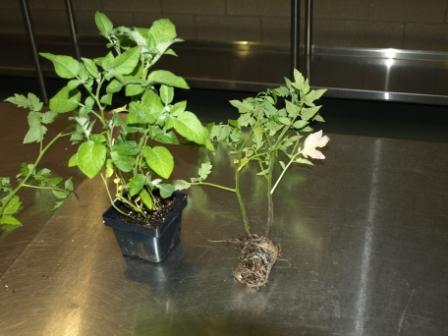
Above we have a young potato and tomato plant to be grafted.

In the above picture the potato and tomato plant have been planted in the same container and their lower leaves have been stripped off.
After the two plants are in the same container a small slice is made on each plant at the same height. This slice will be, ideally, just a little bit deeper than the cambium into the center of the stem (you’ll be able to see the plants pith — in the center of the cut — it’s tough to see in the image here).
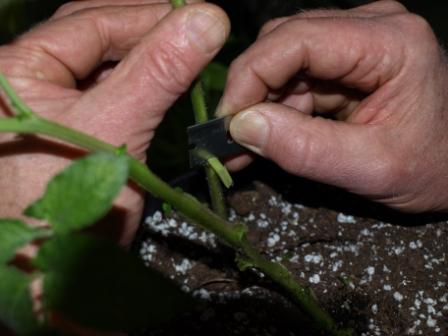
In the above picture the stem of both the tomato and potato are cut so that they can be joined together.
After making the required cuts on both plants the cuts are pushed together and wrapped. We used parafilm to wrap this graft, but saranwrap, or even an elastic band would also work.
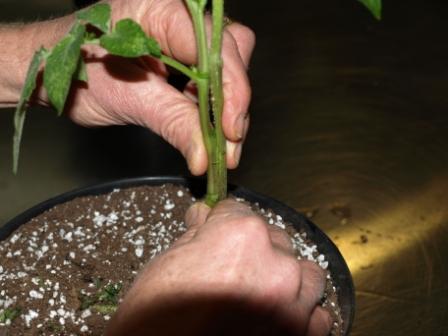
In the above picture the cuts are being joined.
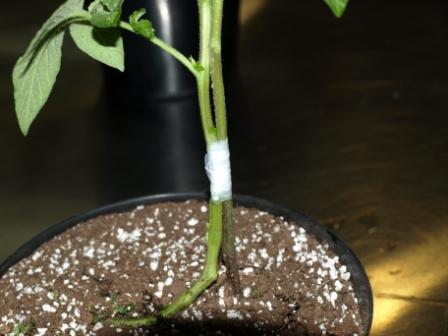
Here the cuts are wrapped.
The next step is to wait until the graft “takes”. This could take 3-5 weeks. After a good strong union is formed the top of the potato and the bottom of the tomato plants are cut off. Wait a few days to make sure everything’s working properly and plant the result in your garden.
Visiting Professor guest post: Native wildflowers
Recently I have been fascinated by the native wildflower field I planted last fall. Although I seeded it with the same mixture of seeds (mixed with sand to spread them evenly), you can see that we have clumps of different flowers throughout the area.

Figure 1. Descanso Gardens, California
The area where the wildflowers were planted had several 1-2 foot raised mounds; some were in the shape of keyholes. These were built with silty sand from a nearby seasonal stream that had some erosion problems in a rainy year.
Small differences between the temperature, moisture, light and soil on the different parts of each mound have favored different species of wildflowers. In one of the keyholes, I even found some miner’s lettuce (Claytonia perfoliata), a species I had not seeded that favors wetter areas. If I sampled for insects, I bet I might find a similar patchy distribution as well.
As an ecologist/biologist, I am really fascinated by the way that species diversity can be affected by topography, climate, moisture, and soils. As a gardener, I like that I could create conditions that favor different plants just by moving soil around. Plus I think that the waves of color are lovely as well.

Rachel Young is the head of the California Garden at Descanso Gardens, just outside Los Angeles. She has an MS degree in Ecology and Evolutionary biology from UCLA and lectures on various garden and horticulture related topics.
Some Super-Cool Stuff
For the past ten years or so I’ve worked to try to transfer information about horticulture to people. It sounds simple, but it actually took a lot of time and effort to figure out the best way to do it, and I’m still not there yet — and probably never will be. The reason that I mention this is because I appreciate it when another horticulturist, such as my fellow garden professors, work to get information about horticulture out to the public. So yesterday we had a speaker come to our depoartment to give our annual end of the year lecture — It’s kind of a big deal for us — We usually have a big name person (horticulturally speaking of course) and pay him or her pretty well and have a reception. It’s nice. We also hand out scholarships to our undergraduates who earned them and any awards which we have to give. But anyway, back to the speaker. This year we had a guy come in who I’d never heard of before besides some strong recommendations from some of my colleagues here in the department. I also did a cursory check of his website. I liked what I saw, but I wasn’t blown away. Sometimes I’m such a dingbat. Simply put, this guy gave one of the top two or three horticultural (actually I should say botanical — it’s more botany than horticulture) presentations which I have seen. His name is Roger Hangarter and he is a professor at Indiana University. In a nutshell he films plant’s moving using time-lapse photography to demonstrate important concepts. Here is one of his websites:
http://plantsinmotion.bio.indiana.edu/plantmotion/starthere.html
But if you do a google search for him he has a lot of other things on different sites. He has even created a traveling display for museums called slowlife. Very, very cool. There aren’t a lot of people who I’m in awe of — but this guy is one of them. If you have a garden club or run a master gardener program you NEED to get this guy on your calendar if you can.